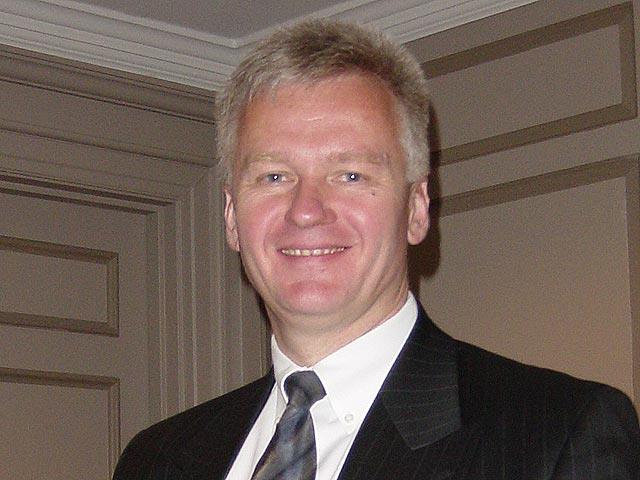 Dirk von Holt ... virtually limitless |
Predictions that battery electric forklifts would gradually take over the lion's share of the market have fallen short of the mark, writes BERNARD LEVY in the second and final part of his report on batteries technology.Tighter StandardsThe debate over internal combustion (IC) engines versus electric has gone through various stages in the last 15-20 years, as the rival industries producing these technologies come up with new and inventive ways to give their products the leading edge in the marketplace. Demand for electric has grown as a result of tighter emission and noise standards from such groups as the Occupational Safety & Health Administration (OSHA) in the US, the UK's Health & Safety Executive (HSE) and the European Agency for Safety & Health at Work. However, the IC sector has been busily trying to keep pace by further cleaning up its act.
The tougher standards, particularly in confined spaces such as warehouses and distribution centres, mean that forklift customers and users must reduce emissions such as nitrous oxide, methane and non-methane hydrocarbons, and carbon monoxide produced by large spark-ignition machines.
Significant shiftOne obvious answer to meeting the tougher standards has long been the electric forklift truck, which whistles around open spaces and up and down narrow aisles and lanes with little noise and zero emissions.
Back in the early 1990s, for example, when the forklift market share was split approximately 55-52 per cent to 45-48 per cent in favour of IC machines, industry leaders were predicting a significant shift to battery power.
In fact, examples of a 60/40 market share for electric forklifts can be found in various parts of the world, although there is no consistency in the pattern.
According to the latest US Industrial Truck Association (ITA) figures, electric trucks (Class I, II and III) represent 56.2 per cent of forklift trucks sold in the US, with gas-fuelled machines accounting for 43.8 per cent.
IC 'workhorses'"Electric forklifts have outsold IC machines in the US since 1982," the ITA president
Dirk von Holt, told Forkliftaction.com. Von Holt also heads up forklift maker Jungheinrich in the US.
"But don't forget that for years, forklifts powered by diesel and gas engines have been the workhorse for industrial and commercial materials handling of heavy loads," he said.
"The noise, emission and performance limitations of conventional forklifts were accepted as a necessary evil.
"However, now that an 80-volt, 5000-6000-pound (2268-2722kg) capacity truck is available, the applications arena for the electric forklift is virtually limitless - they are no longer restricted to lighter duties."
Traditionally, the advantage held by IC-powered forklifts has been power and their ability to move heavy loads quickly and efficiently over any terrain.
More specifically they can climb ramps and grades, accelerate faster, reach higher top-end speeds and lift loads faster.
Capacity limitsBut with the advent of 48-volt and 80-volt alternating current (AC) batteries, electric forklifts offer several advantages including high performance, reduced maintenance and improved energy consumption, amongst others.
However, the load capacity limits for electric trucks have remained a drawback, with operators wanting the freedom and flexibility to convey all loads with a single forklift truck.
Operators also experience greater comfort using electric forklifts because they are quieter and cleaner.
Another benefit is that less vibration is transferred from the engine through the seat, floorboard or steering wheel, allowing operators to remain more alert and less fatigued, especially during long periods of use.
While few forklift industry players expect IC motors to ever be totally free of emissions or noise, these drawbacks are being addressed and have resulted in the IC sector clawing back some lost ground.
An example is Toyota's efforts to recirculate emissions, thus reducing exhaust fumes.
Another is Linde's use of new-generation Volkswagen engines that are designed to drastically reduce the noise level, even at peak performance.
Huge improvementsCategory manager in Century Yuasa Batteries' industrial products division,
Murray Craig, said one factor that may have put people off electric power in the past was the perception that batteries were high-maintenance products.
"But there have been huge improvements in battery watering systems, new AC drive motors with regenerative braking capabilities, improved battery-charging technology - not to mention computerised monitoring and sophisticated, centralised management systems for large banks of batteries," Craig said.
"These have all contributed to making electric power for forklifts more attractive."
 Tony Stewart ... massive savings |
In Europe, engineering services manager for UK-based supply chain giant Wincanton,
Tony Stewart, said the company operated 60 per cent electric forklifts to 40 per cent diesel and gas.
"This is a consequence of things like the Kyoto Agreement and the Euro 2 and Euro 3 emission standards, which the HSE enforces very rigorously," Stewart said.
"But we don't necessarily have a set standard in terms of using electric or IC - it all depends on the application.
"For example, where foodstuffs are involved, obviously we will use electric," he said.
Relatively costlyHowever, Stewart said that in general terms, diesel and gas machines produced "massive savings".
"That figure is between 3-4 per cent, which in a company the size of ours, operating in 15 countries, comes to millions of British pounds a year," he added.
Stewart said that despite all the technological advances in recent years, batteries remained relatively costly when it came to replacing a spent unit with a recharged one.
"Huge numbers of man hours go into changing batteries because in most cases it's a two-man operation taking around 10 minutes - and that can be required twice a day," Stewart said.
"But we do not make the laws and we do whatever is required to meet all emission and noise standards, irrespective of the cost."
Both conventional lead-acid batteries and IC engines are being challenged by hydrogen-based fuel-cell technologies, touted as "clean", "green" and "renewable".
Read more about fuel cells in the
first part of our special feature, published in Forkliftaction.com News #173 on September 2, 2004.
This feature is the second and final part of our special series on batteries and industrial chargers. If you missed part one of the series, click here to read it.